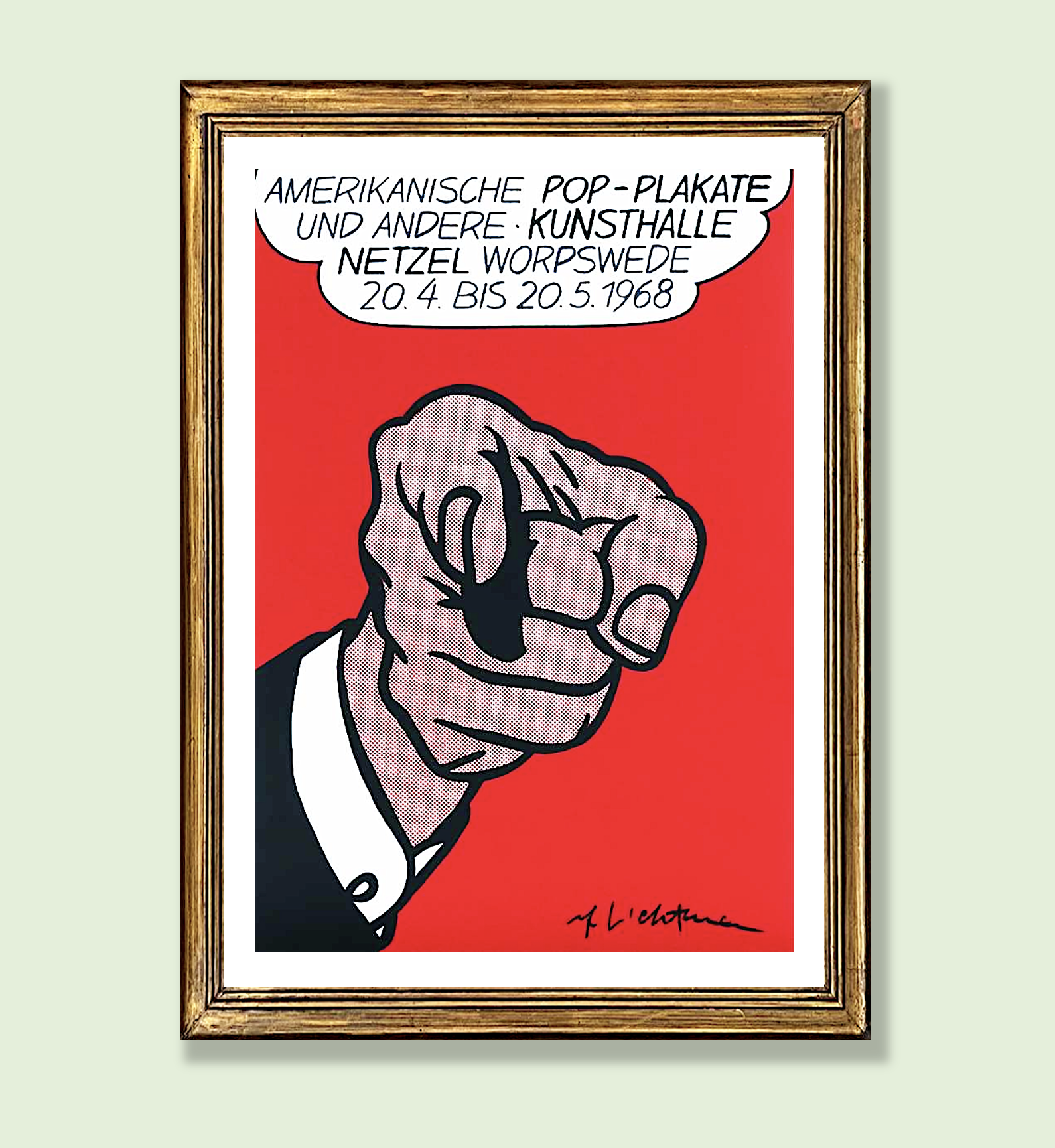

Title: Hey You! Pop Poster Art Signed By Artist Roy Lichtenstein
Shipping: $39.00
Artist: N/A
Period: 20th Century
History: N/A
Origin: N/A
Condition: Museum Quality
Item Date: 1968
Item ID: 5604
A masterpiece, by the very talented artist Roy Lichtenstein. Signed Roy Lichtenstein (American, 1923-1997) Poster. 24-1/4" x 17-1/4" Hand signed in marker, exhibition poster of an image (Finger Pointing or Hey You!) by Lichtenstein, reading "Amerikanische Pop-Plakate und andere - Kunsthalle Netzel Worpswede 20.4. Bis 20.5.1968" (American pop posters and other - Kunsthalle Netzel Worpswede 20.4 to 20.5 1968". Not framed. Condition: Good; never framed. Pop Art Print: Roy Lichtenstein famously began his career as a professional artist when one of his sons challenged him to paint a good copy of an image of Mickey Mouse in a comic book. He went on to establish himself as one of the most influential figures in the pop art movement, creating bold and legendary paintings such as the one featured on this gorgeous art print, entitled 'Hey You!'. He was one of the most important 20th century Pop artists. Roy Lichtenstein's work came directly from the pages of pulp fiction novels and comic books. Lichtenstein (1923 – 1997) originally taught at a university, drawing inspiration from artists who depicted everyday life. He first painted semi-abstract Old West scenes, before shifting to Americana. He later produced comic strip scenes printed with a process that replicated comic book-style dots. In other works, Lichtenstein explored the contradictions of three dimensions represented on flat surfaces. After Andy Warhol, Roy Lichtenstein is considered a founding figure of Pop-Art movement. After studying at the Art Students; League in New York he served during World War II. He then studied at Ohio State University. Like Warhol he started his career in commercial graphics. His trademark cartoon paintings began in 1961. Lichtenstein worked with stencils, painstakingly producing rows of oversized dots (called benday dots) which make his paintings look like a huge mass publication and cartoon strips. Aside from painting he produced lithographs, screenprints, etchings and woodcuts. Three years before his death in 1997, he was honored with a major retrospective at the Guggenheim in NY.
Link: http://en.wikipedia.org/wiki/Roy_Lichtenstein
Roy Lichtenstein (pronounced ˈlɪktənˌstaɪn/; October 27, 1923 – September 29, 1997) was a prominent American pop artist. During the 1960s, his paintings were exhibited at the Leo Castelli Gallery in New York City and, along with Andy Warhol, Jasper Johns, James Rosenquist, and others. He became a leading figure in the new art movement. His work defined the basic premise of pop art better than any other through parody. Favoring the old-fashioned comic strip as subject matter, Lichtenstein produced hard-edged, precise compositions that documented while it parodied often in a tongue-in-cheek humorous manner. His work was heavily influenced by both popular advertising and the comic book style. He described Pop Art as, "not 'American' painting but actually industrial painting".
Roy Lichtenstein was born in New York City into an upper-middle-class Jewish family. His father, Milton, was a real estate broker, his mother, Beatrice Werner, a homemaker. He was raised on the Upper West Side and attended public school until the age of twelve. He then enrolled at New York's Franklin School for Boys, remaining there for his secondary education. Lichtenstein first became interested in art and design as a hobby, and through school. He was an avid jazz fan, often attending concerts at the Apollo Theater in Harlem. He frequently drew portraits of the musicians playing their instruments. In his last year of high school, 1939, Lichtenstein enrolled in summer classes at the Art Students League of New York, where he worked under the tutelage of Reginald Marsh.
Lichtenstein then left New York to study at the Ohio State University, which offered studio courses and a degree in fine arts. His studies were interrupted by a three-year stint in the army during and after World War II between 1943 and 1946. After being in training programs for languages, engineering, and pilot training, all of which were cancelled, he served as an orderly, draftsman, and artist.
In 1951 Lichtenstein had his first solo exhibition at the Carlebach Gallery in New York. He moved to Cleveland in the same year, where he remained for six years, although he frequently traveled back to New York. During this time he undertook jobs as varied as a draftsman to a window decorator in between periods of painting. His work at this time fluctuated between Cubism and Expressionism.
From 1970 until his death, Lichtenstein split his time between Manhattan and a house near the beach in Southampton, New York.
Lichtenstein began to find fame not just in America but worldwide. He moved back to New York to be at the center of the art scene.